Evaluating Theories and Processes of Employee Selection in HRM
VerifiedAdded on 2020/10/22
|10
|3079
|495
Report
AI Summary
This report examines the theories and processes related to employee selection from the external labor market, focusing on the case of M&S. It delves into the role of the HR department in recruiting and selecting employees, highlighting methods like interviews and psychometric tests. The report explores traditional interview methods, including screening interviews, face-to-face interviews, and final interviews, along with job offer processes and background checks. It discusses the effectiveness of traditional interviews and the concept of predictive validity, including various tools and quantitative review. The report also emphasizes the importance of interview structure, sample size, and the impact of predictive validity on the selection process, providing insights into how to enhance the efficiency and validity of employee selection within an organization.
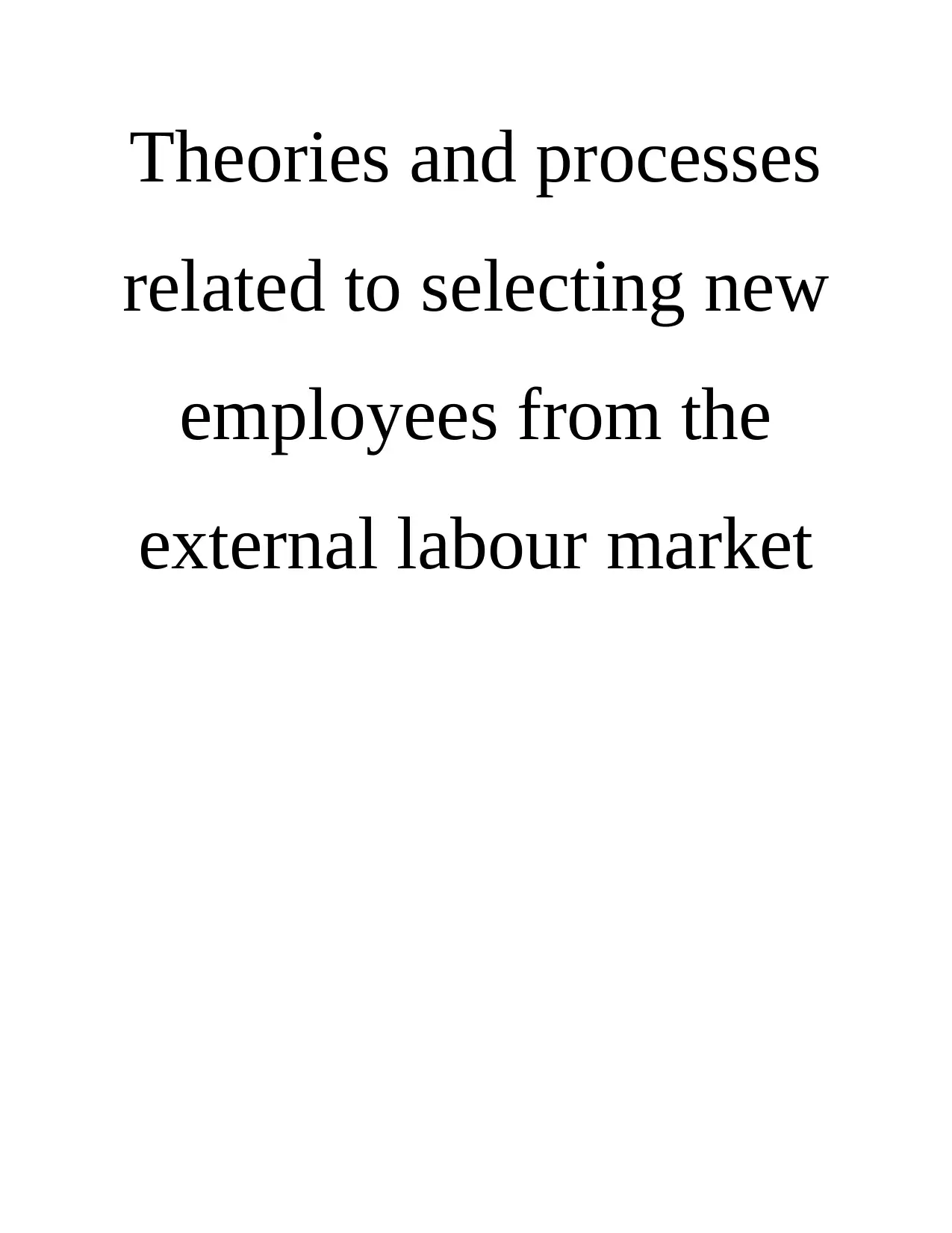
Theories and processes
related to selecting new
employees from the
external labour market
related to selecting new
employees from the
external labour market
Paraphrase This Document
Need a fresh take? Get an instant paraphrase of this document with our AI Paraphraser
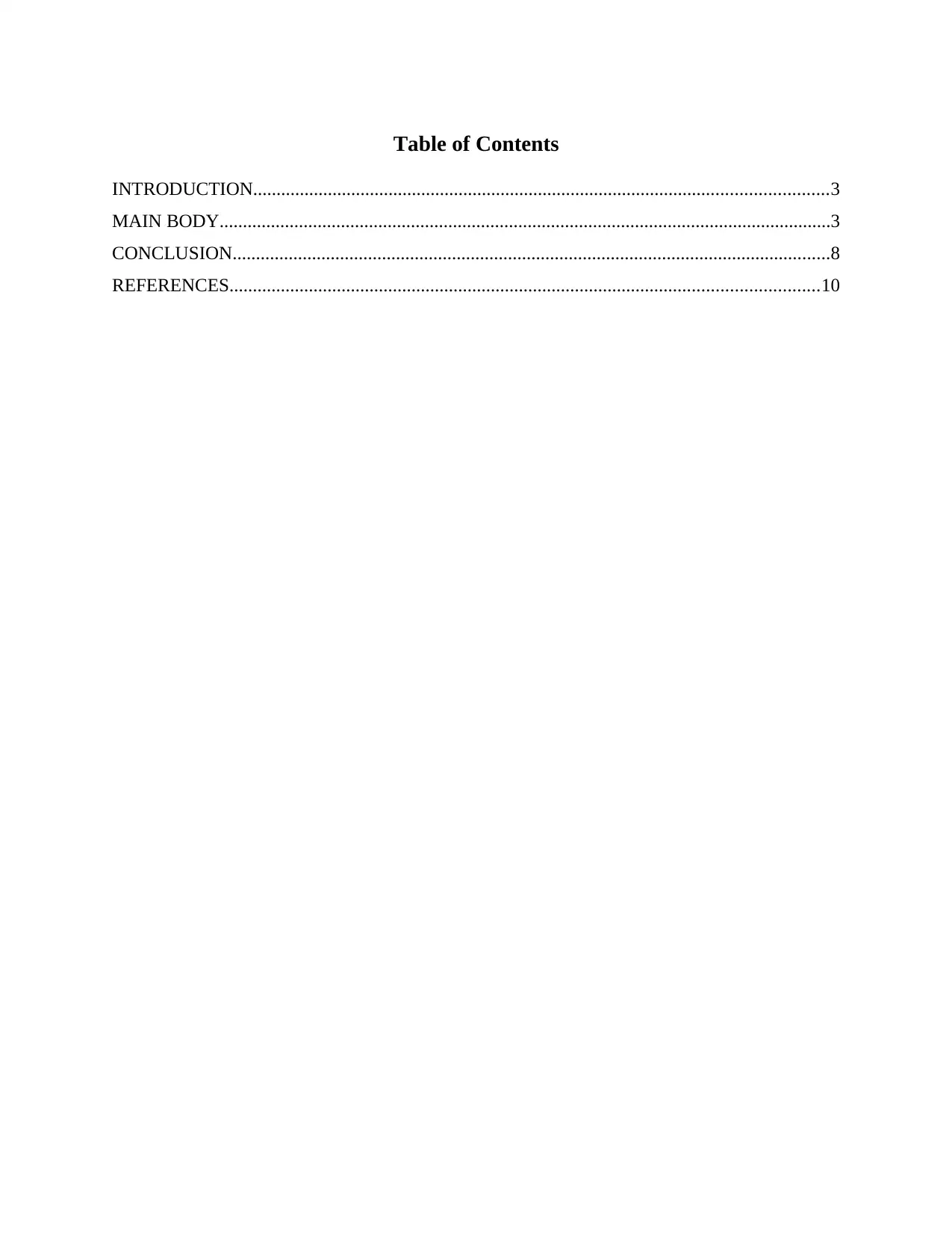
Table of Contents
INTRODUCTION...........................................................................................................................3
MAIN BODY...................................................................................................................................3
CONCLUSION................................................................................................................................8
REFERENCES..............................................................................................................................10
INTRODUCTION...........................................................................................................................3
MAIN BODY...................................................................................................................................3
CONCLUSION................................................................................................................................8
REFERENCES..............................................................................................................................10
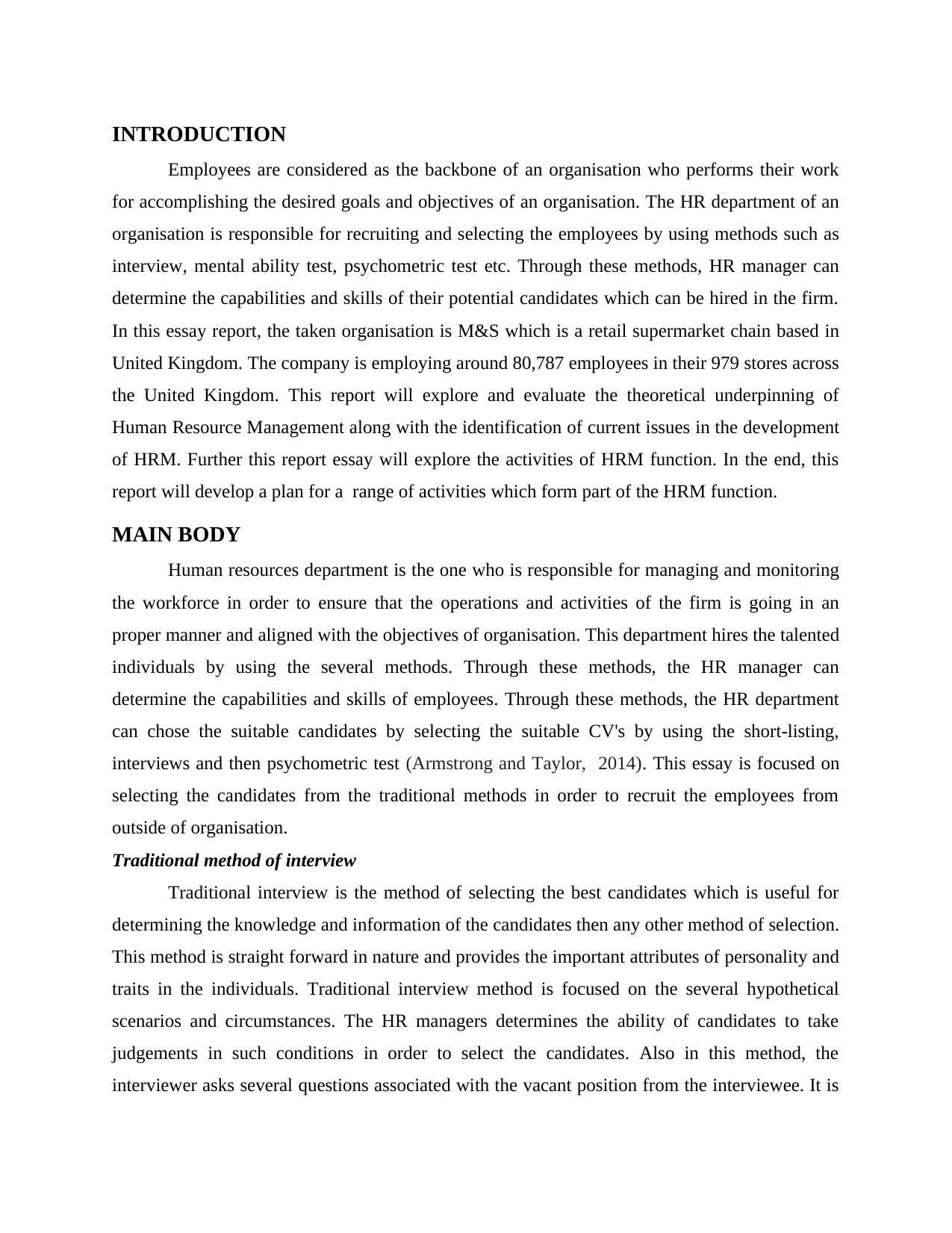
INTRODUCTION
Employees are considered as the backbone of an organisation who performs their work
for accomplishing the desired goals and objectives of an organisation. The HR department of an
organisation is responsible for recruiting and selecting the employees by using methods such as
interview, mental ability test, psychometric test etc. Through these methods, HR manager can
determine the capabilities and skills of their potential candidates which can be hired in the firm.
In this essay report, the taken organisation is M&S which is a retail supermarket chain based in
United Kingdom. The company is employing around 80,787 employees in their 979 stores across
the United Kingdom. This report will explore and evaluate the theoretical underpinning of
Human Resource Management along with the identification of current issues in the development
of HRM. Further this report essay will explore the activities of HRM function. In the end, this
report will develop a plan for a range of activities which form part of the HRM function.
MAIN BODY
Human resources department is the one who is responsible for managing and monitoring
the workforce in order to ensure that the operations and activities of the firm is going in an
proper manner and aligned with the objectives of organisation. This department hires the talented
individuals by using the several methods. Through these methods, the HR manager can
determine the capabilities and skills of employees. Through these methods, the HR department
can chose the suitable candidates by selecting the suitable CV's by using the short-listing,
interviews and then psychometric test (Armstrong and Taylor, 2014). This essay is focused on
selecting the candidates from the traditional methods in order to recruit the employees from
outside of organisation.
Traditional method of interview
Traditional interview is the method of selecting the best candidates which is useful for
determining the knowledge and information of the candidates then any other method of selection.
This method is straight forward in nature and provides the important attributes of personality and
traits in the individuals. Traditional interview method is focused on the several hypothetical
scenarios and circumstances. The HR managers determines the ability of candidates to take
judgements in such conditions in order to select the candidates. Also in this method, the
interviewer asks several questions associated with the vacant position from the interviewee. It is
Employees are considered as the backbone of an organisation who performs their work
for accomplishing the desired goals and objectives of an organisation. The HR department of an
organisation is responsible for recruiting and selecting the employees by using methods such as
interview, mental ability test, psychometric test etc. Through these methods, HR manager can
determine the capabilities and skills of their potential candidates which can be hired in the firm.
In this essay report, the taken organisation is M&S which is a retail supermarket chain based in
United Kingdom. The company is employing around 80,787 employees in their 979 stores across
the United Kingdom. This report will explore and evaluate the theoretical underpinning of
Human Resource Management along with the identification of current issues in the development
of HRM. Further this report essay will explore the activities of HRM function. In the end, this
report will develop a plan for a range of activities which form part of the HRM function.
MAIN BODY
Human resources department is the one who is responsible for managing and monitoring
the workforce in order to ensure that the operations and activities of the firm is going in an
proper manner and aligned with the objectives of organisation. This department hires the talented
individuals by using the several methods. Through these methods, the HR manager can
determine the capabilities and skills of employees. Through these methods, the HR department
can chose the suitable candidates by selecting the suitable CV's by using the short-listing,
interviews and then psychometric test (Armstrong and Taylor, 2014). This essay is focused on
selecting the candidates from the traditional methods in order to recruit the employees from
outside of organisation.
Traditional method of interview
Traditional interview is the method of selecting the best candidates which is useful for
determining the knowledge and information of the candidates then any other method of selection.
This method is straight forward in nature and provides the important attributes of personality and
traits in the individuals. Traditional interview method is focused on the several hypothetical
scenarios and circumstances. The HR managers determines the ability of candidates to take
judgements in such conditions in order to select the candidates. Also in this method, the
interviewer asks several questions associated with the vacant position from the interviewee. It is
⊘ This is a preview!⊘
Do you want full access?
Subscribe today to unlock all pages.

Trusted by 1+ million students worldwide
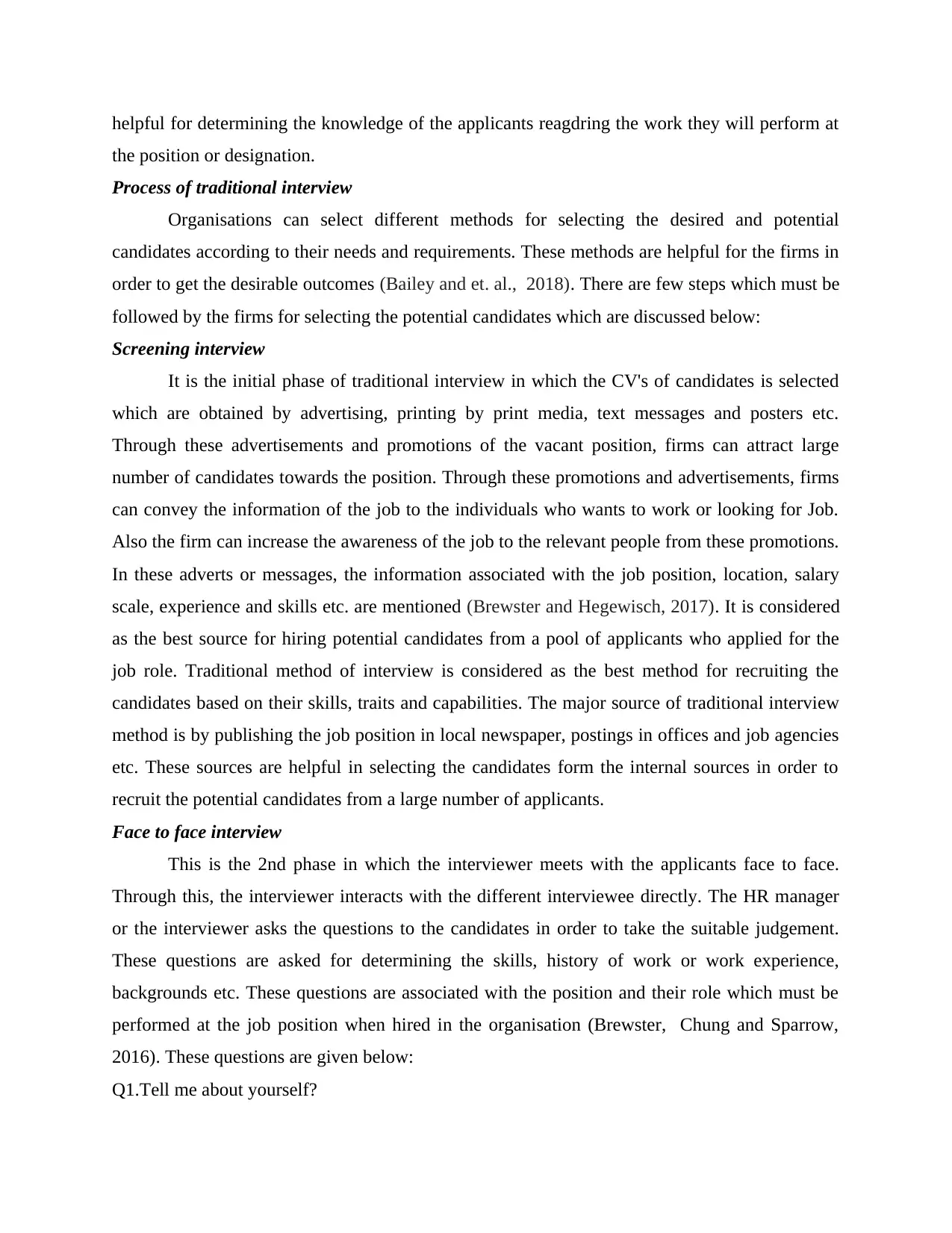
helpful for determining the knowledge of the applicants reagdring the work they will perform at
the position or designation.
Process of traditional interview
Organisations can select different methods for selecting the desired and potential
candidates according to their needs and requirements. These methods are helpful for the firms in
order to get the desirable outcomes (Bailey and et. al., 2018). There are few steps which must be
followed by the firms for selecting the potential candidates which are discussed below:
Screening interview
It is the initial phase of traditional interview in which the CV's of candidates is selected
which are obtained by advertising, printing by print media, text messages and posters etc.
Through these advertisements and promotions of the vacant position, firms can attract large
number of candidates towards the position. Through these promotions and advertisements, firms
can convey the information of the job to the individuals who wants to work or looking for Job.
Also the firm can increase the awareness of the job to the relevant people from these promotions.
In these adverts or messages, the information associated with the job position, location, salary
scale, experience and skills etc. are mentioned (Brewster and Hegewisch, 2017). It is considered
as the best source for hiring potential candidates from a pool of applicants who applied for the
job role. Traditional method of interview is considered as the best method for recruiting the
candidates based on their skills, traits and capabilities. The major source of traditional interview
method is by publishing the job position in local newspaper, postings in offices and job agencies
etc. These sources are helpful in selecting the candidates form the internal sources in order to
recruit the potential candidates from a large number of applicants.
Face to face interview
This is the 2nd phase in which the interviewer meets with the applicants face to face.
Through this, the interviewer interacts with the different interviewee directly. The HR manager
or the interviewer asks the questions to the candidates in order to take the suitable judgement.
These questions are asked for determining the skills, history of work or work experience,
backgrounds etc. These questions are associated with the position and their role which must be
performed at the job position when hired in the organisation (Brewster, Chung and Sparrow,
2016). These questions are given below:
Q1.Tell me about yourself?
the position or designation.
Process of traditional interview
Organisations can select different methods for selecting the desired and potential
candidates according to their needs and requirements. These methods are helpful for the firms in
order to get the desirable outcomes (Bailey and et. al., 2018). There are few steps which must be
followed by the firms for selecting the potential candidates which are discussed below:
Screening interview
It is the initial phase of traditional interview in which the CV's of candidates is selected
which are obtained by advertising, printing by print media, text messages and posters etc.
Through these advertisements and promotions of the vacant position, firms can attract large
number of candidates towards the position. Through these promotions and advertisements, firms
can convey the information of the job to the individuals who wants to work or looking for Job.
Also the firm can increase the awareness of the job to the relevant people from these promotions.
In these adverts or messages, the information associated with the job position, location, salary
scale, experience and skills etc. are mentioned (Brewster and Hegewisch, 2017). It is considered
as the best source for hiring potential candidates from a pool of applicants who applied for the
job role. Traditional method of interview is considered as the best method for recruiting the
candidates based on their skills, traits and capabilities. The major source of traditional interview
method is by publishing the job position in local newspaper, postings in offices and job agencies
etc. These sources are helpful in selecting the candidates form the internal sources in order to
recruit the potential candidates from a large number of applicants.
Face to face interview
This is the 2nd phase in which the interviewer meets with the applicants face to face.
Through this, the interviewer interacts with the different interviewee directly. The HR manager
or the interviewer asks the questions to the candidates in order to take the suitable judgement.
These questions are asked for determining the skills, history of work or work experience,
backgrounds etc. These questions are associated with the position and their role which must be
performed at the job position when hired in the organisation (Brewster, Chung and Sparrow,
2016). These questions are given below:
Q1.Tell me about yourself?
Paraphrase This Document
Need a fresh take? Get an instant paraphrase of this document with our AI Paraphraser
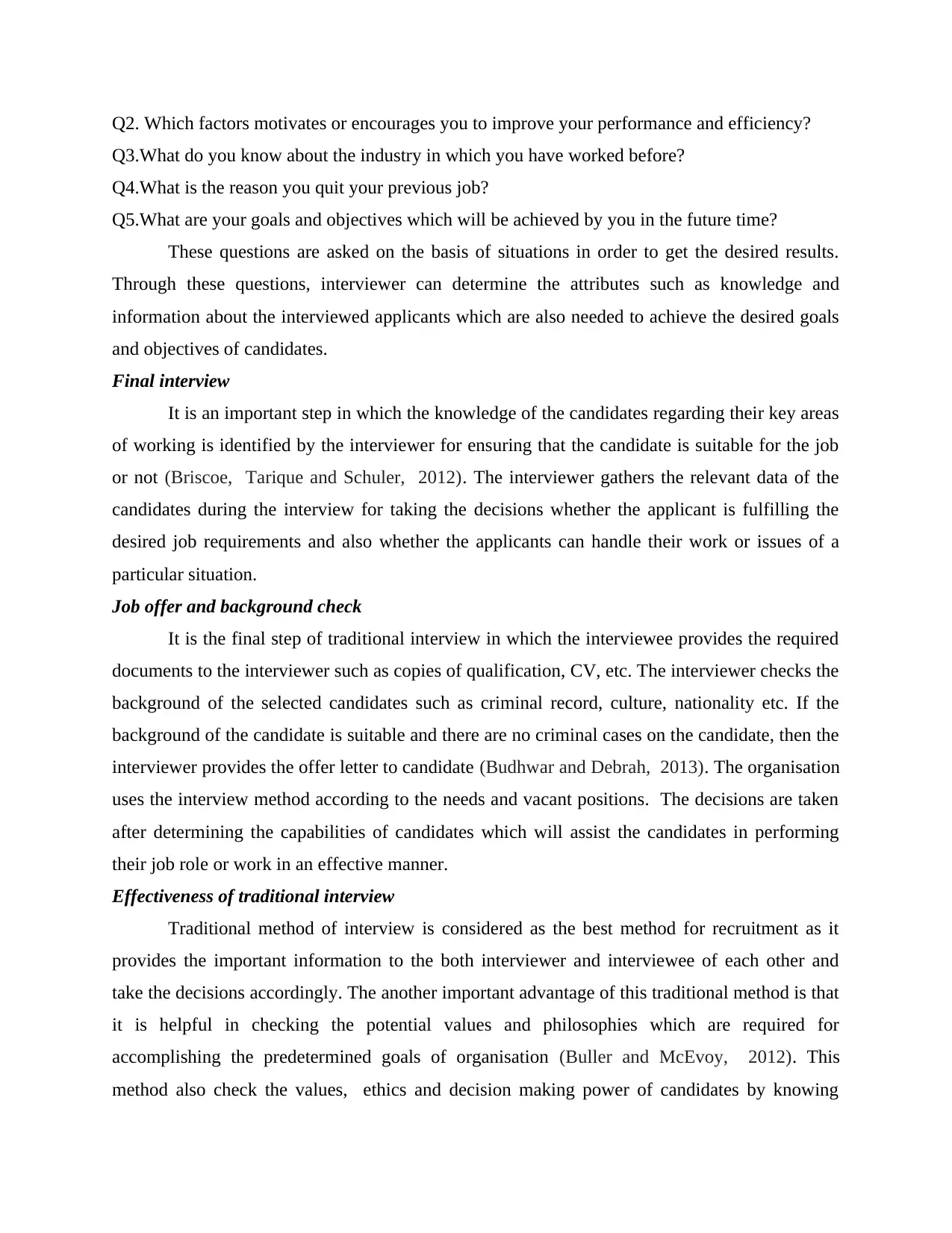
Q2. Which factors motivates or encourages you to improve your performance and efficiency?
Q3.What do you know about the industry in which you have worked before?
Q4.What is the reason you quit your previous job?
Q5.What are your goals and objectives which will be achieved by you in the future time?
These questions are asked on the basis of situations in order to get the desired results.
Through these questions, interviewer can determine the attributes such as knowledge and
information about the interviewed applicants which are also needed to achieve the desired goals
and objectives of candidates.
Final interview
It is an important step in which the knowledge of the candidates regarding their key areas
of working is identified by the interviewer for ensuring that the candidate is suitable for the job
or not (Briscoe, Tarique and Schuler, 2012). The interviewer gathers the relevant data of the
candidates during the interview for taking the decisions whether the applicant is fulfilling the
desired job requirements and also whether the applicants can handle their work or issues of a
particular situation.
Job offer and background check
It is the final step of traditional interview in which the interviewee provides the required
documents to the interviewer such as copies of qualification, CV, etc. The interviewer checks the
background of the selected candidates such as criminal record, culture, nationality etc. If the
background of the candidate is suitable and there are no criminal cases on the candidate, then the
interviewer provides the offer letter to candidate (Budhwar and Debrah, 2013). The organisation
uses the interview method according to the needs and vacant positions. The decisions are taken
after determining the capabilities of candidates which will assist the candidates in performing
their job role or work in an effective manner.
Effectiveness of traditional interview
Traditional method of interview is considered as the best method for recruitment as it
provides the important information to the both interviewer and interviewee of each other and
take the decisions accordingly. The another important advantage of this traditional method is that
it is helpful in checking the potential values and philosophies which are required for
accomplishing the predetermined goals of organisation (Buller and McEvoy, 2012). This
method also check the values, ethics and decision making power of candidates by knowing
Q3.What do you know about the industry in which you have worked before?
Q4.What is the reason you quit your previous job?
Q5.What are your goals and objectives which will be achieved by you in the future time?
These questions are asked on the basis of situations in order to get the desired results.
Through these questions, interviewer can determine the attributes such as knowledge and
information about the interviewed applicants which are also needed to achieve the desired goals
and objectives of candidates.
Final interview
It is an important step in which the knowledge of the candidates regarding their key areas
of working is identified by the interviewer for ensuring that the candidate is suitable for the job
or not (Briscoe, Tarique and Schuler, 2012). The interviewer gathers the relevant data of the
candidates during the interview for taking the decisions whether the applicant is fulfilling the
desired job requirements and also whether the applicants can handle their work or issues of a
particular situation.
Job offer and background check
It is the final step of traditional interview in which the interviewee provides the required
documents to the interviewer such as copies of qualification, CV, etc. The interviewer checks the
background of the selected candidates such as criminal record, culture, nationality etc. If the
background of the candidate is suitable and there are no criminal cases on the candidate, then the
interviewer provides the offer letter to candidate (Budhwar and Debrah, 2013). The organisation
uses the interview method according to the needs and vacant positions. The decisions are taken
after determining the capabilities of candidates which will assist the candidates in performing
their job role or work in an effective manner.
Effectiveness of traditional interview
Traditional method of interview is considered as the best method for recruitment as it
provides the important information to the both interviewer and interviewee of each other and
take the decisions accordingly. The another important advantage of this traditional method is that
it is helpful in checking the potential values and philosophies which are required for
accomplishing the predetermined goals of organisation (Buller and McEvoy, 2012). This
method also check the values, ethics and decision making power of candidates by knowing
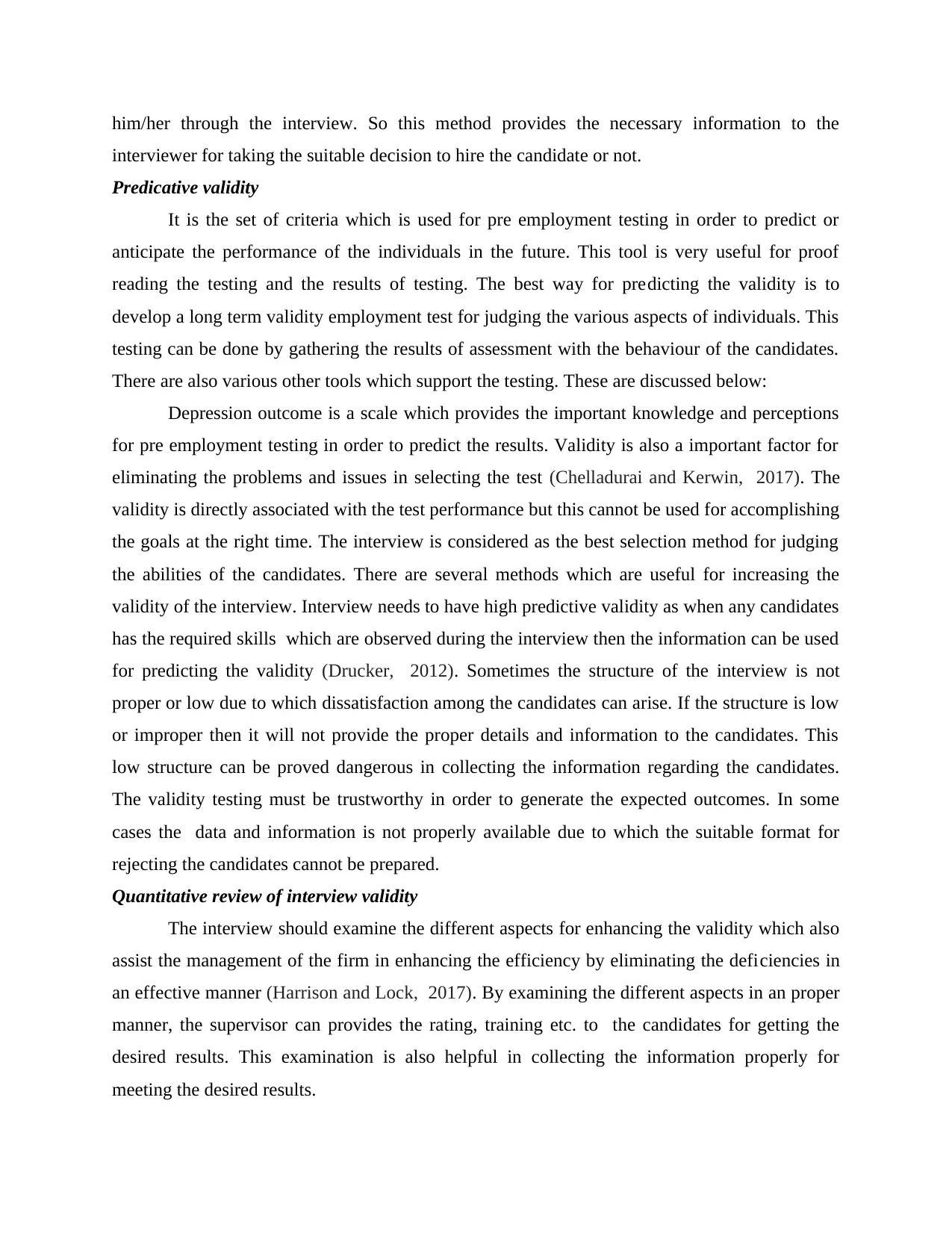
him/her through the interview. So this method provides the necessary information to the
interviewer for taking the suitable decision to hire the candidate or not.
Predicative validity
It is the set of criteria which is used for pre employment testing in order to predict or
anticipate the performance of the individuals in the future. This tool is very useful for proof
reading the testing and the results of testing. The best way for predicting the validity is to
develop a long term validity employment test for judging the various aspects of individuals. This
testing can be done by gathering the results of assessment with the behaviour of the candidates.
There are also various other tools which support the testing. These are discussed below:
Depression outcome is a scale which provides the important knowledge and perceptions
for pre employment testing in order to predict the results. Validity is also a important factor for
eliminating the problems and issues in selecting the test (Chelladurai and Kerwin, 2017). The
validity is directly associated with the test performance but this cannot be used for accomplishing
the goals at the right time. The interview is considered as the best selection method for judging
the abilities of the candidates. There are several methods which are useful for increasing the
validity of the interview. Interview needs to have high predictive validity as when any candidates
has the required skills which are observed during the interview then the information can be used
for predicting the validity (Drucker, 2012). Sometimes the structure of the interview is not
proper or low due to which dissatisfaction among the candidates can arise. If the structure is low
or improper then it will not provide the proper details and information to the candidates. This
low structure can be proved dangerous in collecting the information regarding the candidates.
The validity testing must be trustworthy in order to generate the expected outcomes. In some
cases the data and information is not properly available due to which the suitable format for
rejecting the candidates cannot be prepared.
Quantitative review of interview validity
The interview should examine the different aspects for enhancing the validity which also
assist the management of the firm in enhancing the efficiency by eliminating the deficiencies in
an effective manner (Harrison and Lock, 2017). By examining the different aspects in an proper
manner, the supervisor can provides the rating, training etc. to the candidates for getting the
desired results. This examination is also helpful in collecting the information properly for
meeting the desired results.
interviewer for taking the suitable decision to hire the candidate or not.
Predicative validity
It is the set of criteria which is used for pre employment testing in order to predict or
anticipate the performance of the individuals in the future. This tool is very useful for proof
reading the testing and the results of testing. The best way for predicting the validity is to
develop a long term validity employment test for judging the various aspects of individuals. This
testing can be done by gathering the results of assessment with the behaviour of the candidates.
There are also various other tools which support the testing. These are discussed below:
Depression outcome is a scale which provides the important knowledge and perceptions
for pre employment testing in order to predict the results. Validity is also a important factor for
eliminating the problems and issues in selecting the test (Chelladurai and Kerwin, 2017). The
validity is directly associated with the test performance but this cannot be used for accomplishing
the goals at the right time. The interview is considered as the best selection method for judging
the abilities of the candidates. There are several methods which are useful for increasing the
validity of the interview. Interview needs to have high predictive validity as when any candidates
has the required skills which are observed during the interview then the information can be used
for predicting the validity (Drucker, 2012). Sometimes the structure of the interview is not
proper or low due to which dissatisfaction among the candidates can arise. If the structure is low
or improper then it will not provide the proper details and information to the candidates. This
low structure can be proved dangerous in collecting the information regarding the candidates.
The validity testing must be trustworthy in order to generate the expected outcomes. In some
cases the data and information is not properly available due to which the suitable format for
rejecting the candidates cannot be prepared.
Quantitative review of interview validity
The interview should examine the different aspects for enhancing the validity which also
assist the management of the firm in enhancing the efficiency by eliminating the deficiencies in
an effective manner (Harrison and Lock, 2017). By examining the different aspects in an proper
manner, the supervisor can provides the rating, training etc. to the candidates for getting the
desired results. This examination is also helpful in collecting the information properly for
meeting the desired results.
⊘ This is a preview!⊘
Do you want full access?
Subscribe today to unlock all pages.

Trusted by 1+ million students worldwide
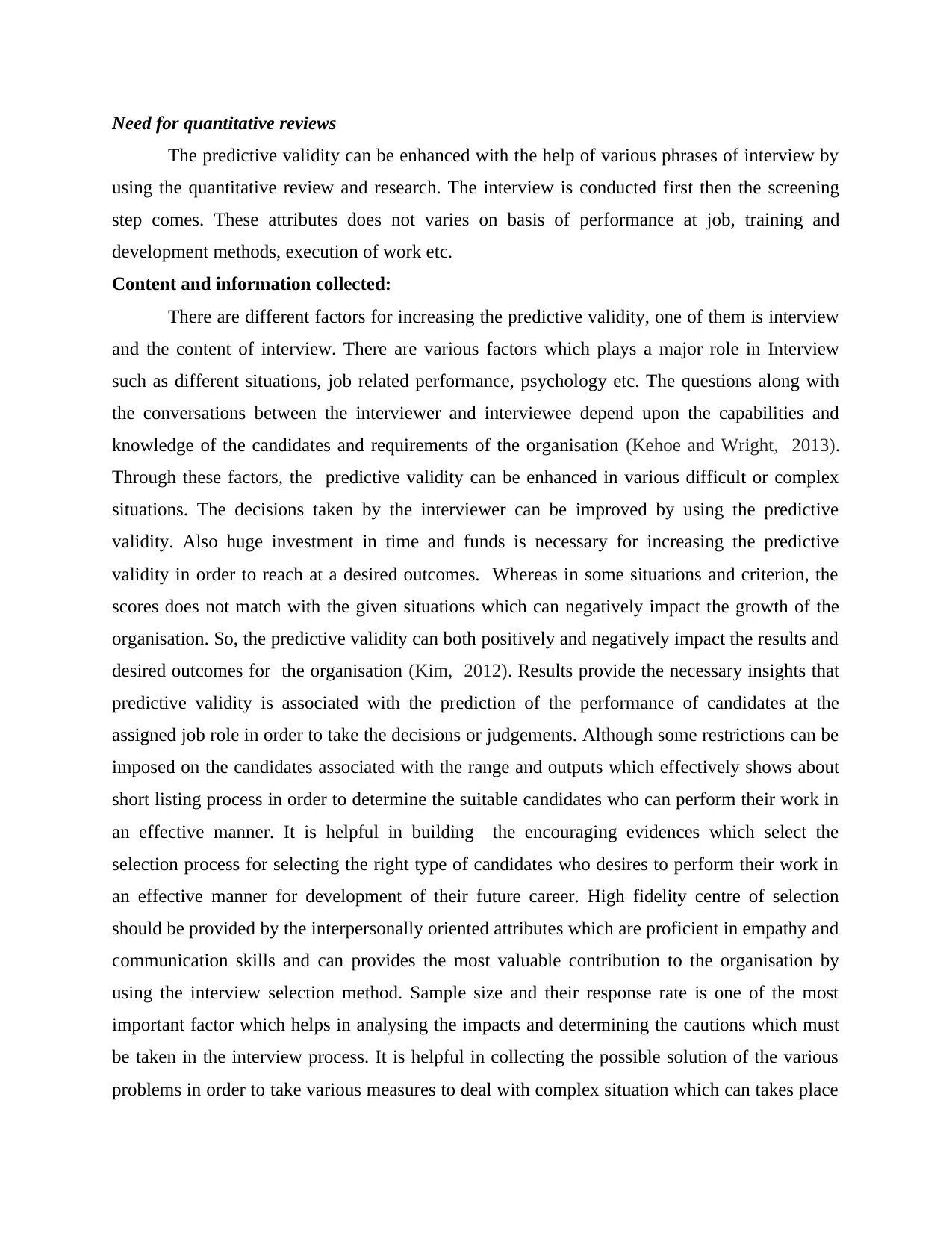
Need for quantitative reviews
The predictive validity can be enhanced with the help of various phrases of interview by
using the quantitative review and research. The interview is conducted first then the screening
step comes. These attributes does not varies on basis of performance at job, training and
development methods, execution of work etc.
Content and information collected:
There are different factors for increasing the predictive validity, one of them is interview
and the content of interview. There are various factors which plays a major role in Interview
such as different situations, job related performance, psychology etc. The questions along with
the conversations between the interviewer and interviewee depend upon the capabilities and
knowledge of the candidates and requirements of the organisation (Kehoe and Wright, 2013).
Through these factors, the predictive validity can be enhanced in various difficult or complex
situations. The decisions taken by the interviewer can be improved by using the predictive
validity. Also huge investment in time and funds is necessary for increasing the predictive
validity in order to reach at a desired outcomes. Whereas in some situations and criterion, the
scores does not match with the given situations which can negatively impact the growth of the
organisation. So, the predictive validity can both positively and negatively impact the results and
desired outcomes for the organisation (Kim, 2012). Results provide the necessary insights that
predictive validity is associated with the prediction of the performance of candidates at the
assigned job role in order to take the decisions or judgements. Although some restrictions can be
imposed on the candidates associated with the range and outputs which effectively shows about
short listing process in order to determine the suitable candidates who can perform their work in
an effective manner. It is helpful in building the encouraging evidences which select the
selection process for selecting the right type of candidates who desires to perform their work in
an effective manner for development of their future career. High fidelity centre of selection
should be provided by the interpersonally oriented attributes which are proficient in empathy and
communication skills and can provides the most valuable contribution to the organisation by
using the interview selection method. Sample size and their response rate is one of the most
important factor which helps in analysing the impacts and determining the cautions which must
be taken in the interview process. It is helpful in collecting the possible solution of the various
problems in order to take various measures to deal with complex situation which can takes place
The predictive validity can be enhanced with the help of various phrases of interview by
using the quantitative review and research. The interview is conducted first then the screening
step comes. These attributes does not varies on basis of performance at job, training and
development methods, execution of work etc.
Content and information collected:
There are different factors for increasing the predictive validity, one of them is interview
and the content of interview. There are various factors which plays a major role in Interview
such as different situations, job related performance, psychology etc. The questions along with
the conversations between the interviewer and interviewee depend upon the capabilities and
knowledge of the candidates and requirements of the organisation (Kehoe and Wright, 2013).
Through these factors, the predictive validity can be enhanced in various difficult or complex
situations. The decisions taken by the interviewer can be improved by using the predictive
validity. Also huge investment in time and funds is necessary for increasing the predictive
validity in order to reach at a desired outcomes. Whereas in some situations and criterion, the
scores does not match with the given situations which can negatively impact the growth of the
organisation. So, the predictive validity can both positively and negatively impact the results and
desired outcomes for the organisation (Kim, 2012). Results provide the necessary insights that
predictive validity is associated with the prediction of the performance of candidates at the
assigned job role in order to take the decisions or judgements. Although some restrictions can be
imposed on the candidates associated with the range and outputs which effectively shows about
short listing process in order to determine the suitable candidates who can perform their work in
an effective manner. It is helpful in building the encouraging evidences which select the
selection process for selecting the right type of candidates who desires to perform their work in
an effective manner for development of their future career. High fidelity centre of selection
should be provided by the interpersonally oriented attributes which are proficient in empathy and
communication skills and can provides the most valuable contribution to the organisation by
using the interview selection method. Sample size and their response rate is one of the most
important factor which helps in analysing the impacts and determining the cautions which must
be taken in the interview process. It is helpful in collecting the possible solution of the various
problems in order to take various measures to deal with complex situation which can takes place
Paraphrase This Document
Need a fresh take? Get an instant paraphrase of this document with our AI Paraphraser
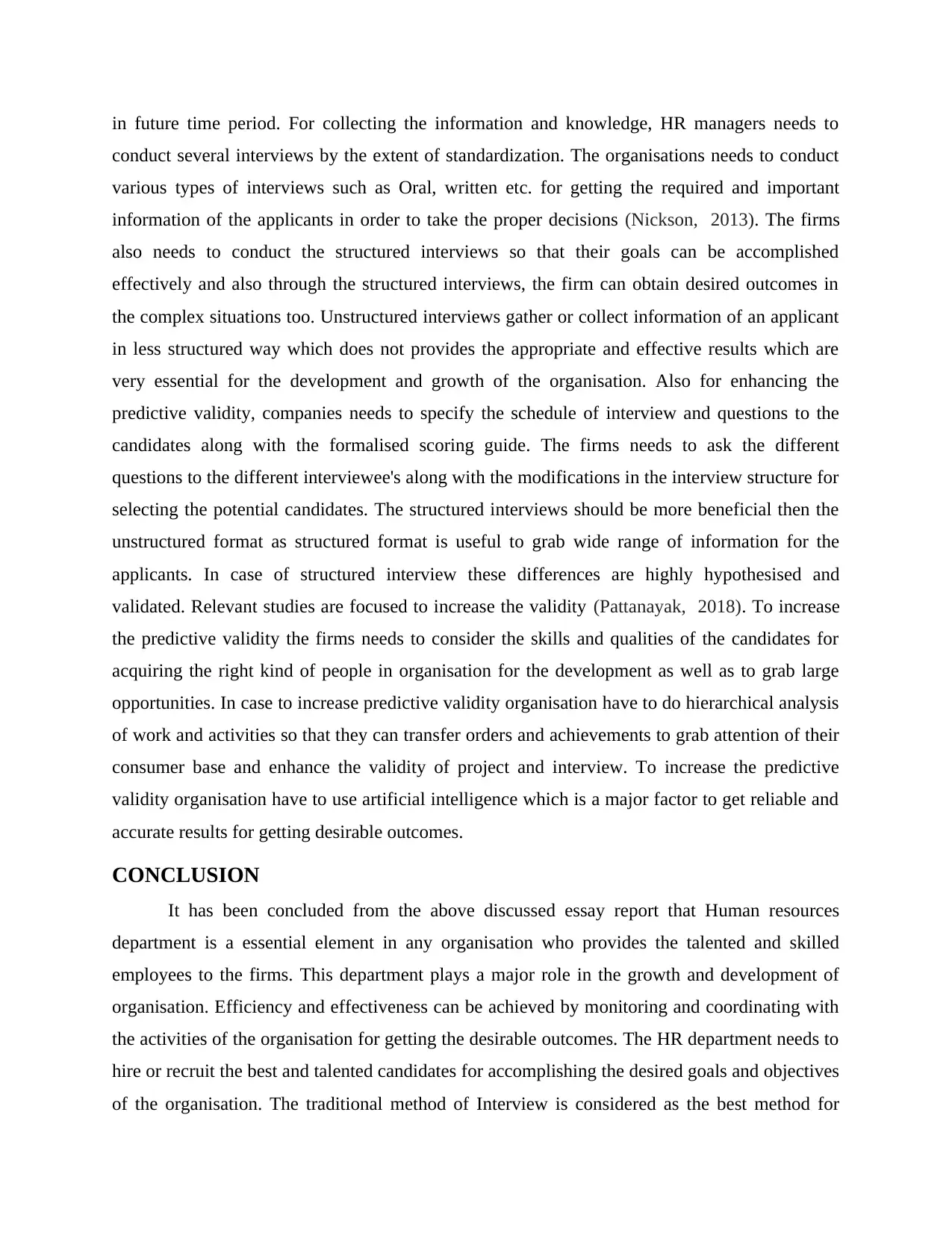
in future time period. For collecting the information and knowledge, HR managers needs to
conduct several interviews by the extent of standardization. The organisations needs to conduct
various types of interviews such as Oral, written etc. for getting the required and important
information of the applicants in order to take the proper decisions (Nickson, 2013). The firms
also needs to conduct the structured interviews so that their goals can be accomplished
effectively and also through the structured interviews, the firm can obtain desired outcomes in
the complex situations too. Unstructured interviews gather or collect information of an applicant
in less structured way which does not provides the appropriate and effective results which are
very essential for the development and growth of the organisation. Also for enhancing the
predictive validity, companies needs to specify the schedule of interview and questions to the
candidates along with the formalised scoring guide. The firms needs to ask the different
questions to the different interviewee's along with the modifications in the interview structure for
selecting the potential candidates. The structured interviews should be more beneficial then the
unstructured format as structured format is useful to grab wide range of information for the
applicants. In case of structured interview these differences are highly hypothesised and
validated. Relevant studies are focused to increase the validity (Pattanayak, 2018). To increase
the predictive validity the firms needs to consider the skills and qualities of the candidates for
acquiring the right kind of people in organisation for the development as well as to grab large
opportunities. In case to increase predictive validity organisation have to do hierarchical analysis
of work and activities so that they can transfer orders and achievements to grab attention of their
consumer base and enhance the validity of project and interview. To increase the predictive
validity organisation have to use artificial intelligence which is a major factor to get reliable and
accurate results for getting desirable outcomes.
CONCLUSION
It has been concluded from the above discussed essay report that Human resources
department is a essential element in any organisation who provides the talented and skilled
employees to the firms. This department plays a major role in the growth and development of
organisation. Efficiency and effectiveness can be achieved by monitoring and coordinating with
the activities of the organisation for getting the desirable outcomes. The HR department needs to
hire or recruit the best and talented candidates for accomplishing the desired goals and objectives
of the organisation. The traditional method of Interview is considered as the best method for
conduct several interviews by the extent of standardization. The organisations needs to conduct
various types of interviews such as Oral, written etc. for getting the required and important
information of the applicants in order to take the proper decisions (Nickson, 2013). The firms
also needs to conduct the structured interviews so that their goals can be accomplished
effectively and also through the structured interviews, the firm can obtain desired outcomes in
the complex situations too. Unstructured interviews gather or collect information of an applicant
in less structured way which does not provides the appropriate and effective results which are
very essential for the development and growth of the organisation. Also for enhancing the
predictive validity, companies needs to specify the schedule of interview and questions to the
candidates along with the formalised scoring guide. The firms needs to ask the different
questions to the different interviewee's along with the modifications in the interview structure for
selecting the potential candidates. The structured interviews should be more beneficial then the
unstructured format as structured format is useful to grab wide range of information for the
applicants. In case of structured interview these differences are highly hypothesised and
validated. Relevant studies are focused to increase the validity (Pattanayak, 2018). To increase
the predictive validity the firms needs to consider the skills and qualities of the candidates for
acquiring the right kind of people in organisation for the development as well as to grab large
opportunities. In case to increase predictive validity organisation have to do hierarchical analysis
of work and activities so that they can transfer orders and achievements to grab attention of their
consumer base and enhance the validity of project and interview. To increase the predictive
validity organisation have to use artificial intelligence which is a major factor to get reliable and
accurate results for getting desirable outcomes.
CONCLUSION
It has been concluded from the above discussed essay report that Human resources
department is a essential element in any organisation who provides the talented and skilled
employees to the firms. This department plays a major role in the growth and development of
organisation. Efficiency and effectiveness can be achieved by monitoring and coordinating with
the activities of the organisation for getting the desirable outcomes. The HR department needs to
hire or recruit the best and talented candidates for accomplishing the desired goals and objectives
of the organisation. The traditional method of Interview is considered as the best method for
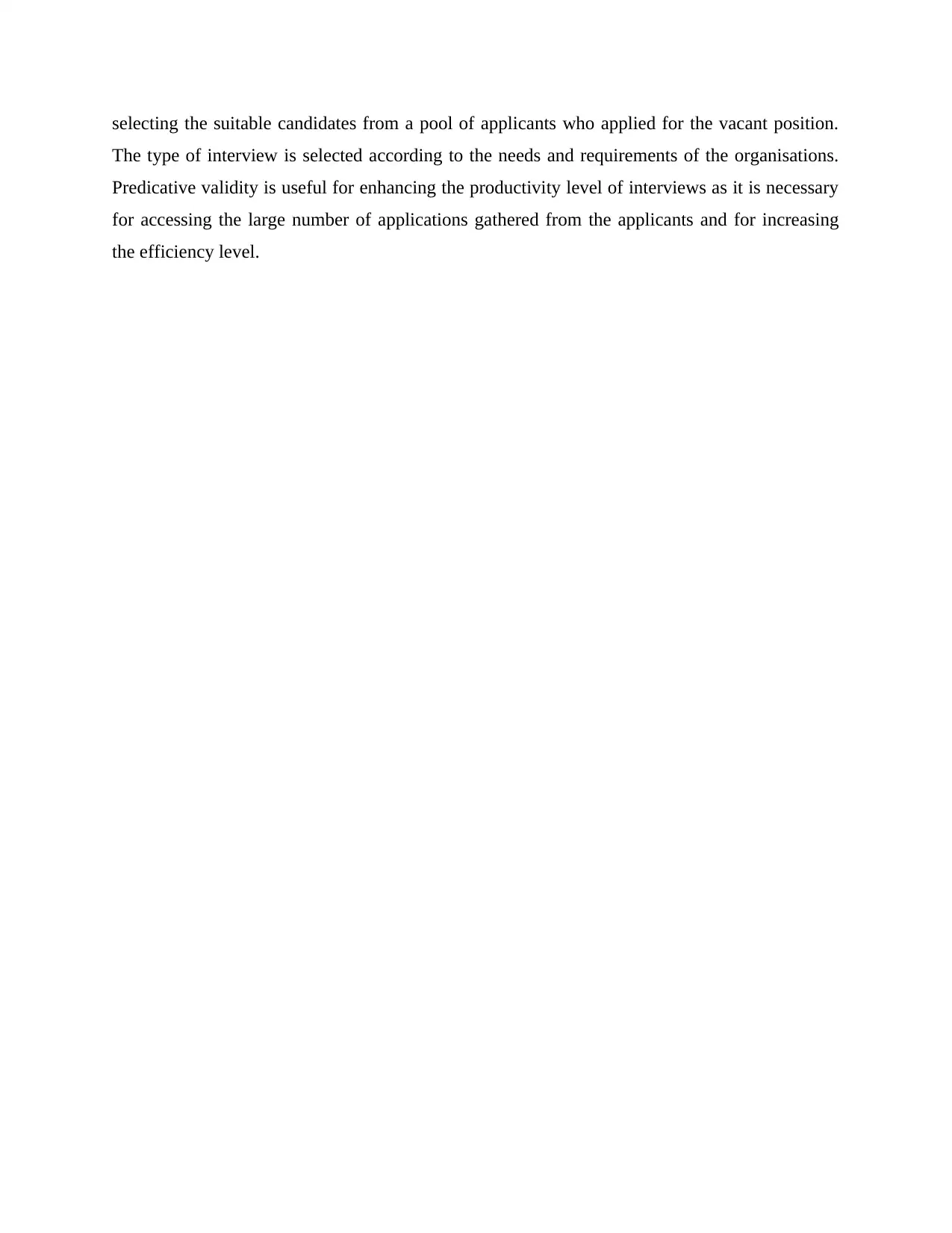
selecting the suitable candidates from a pool of applicants who applied for the vacant position.
The type of interview is selected according to the needs and requirements of the organisations.
Predicative validity is useful for enhancing the productivity level of interviews as it is necessary
for accessing the large number of applications gathered from the applicants and for increasing
the efficiency level.
The type of interview is selected according to the needs and requirements of the organisations.
Predicative validity is useful for enhancing the productivity level of interviews as it is necessary
for accessing the large number of applications gathered from the applicants and for increasing
the efficiency level.
⊘ This is a preview!⊘
Do you want full access?
Subscribe today to unlock all pages.

Trusted by 1+ million students worldwide
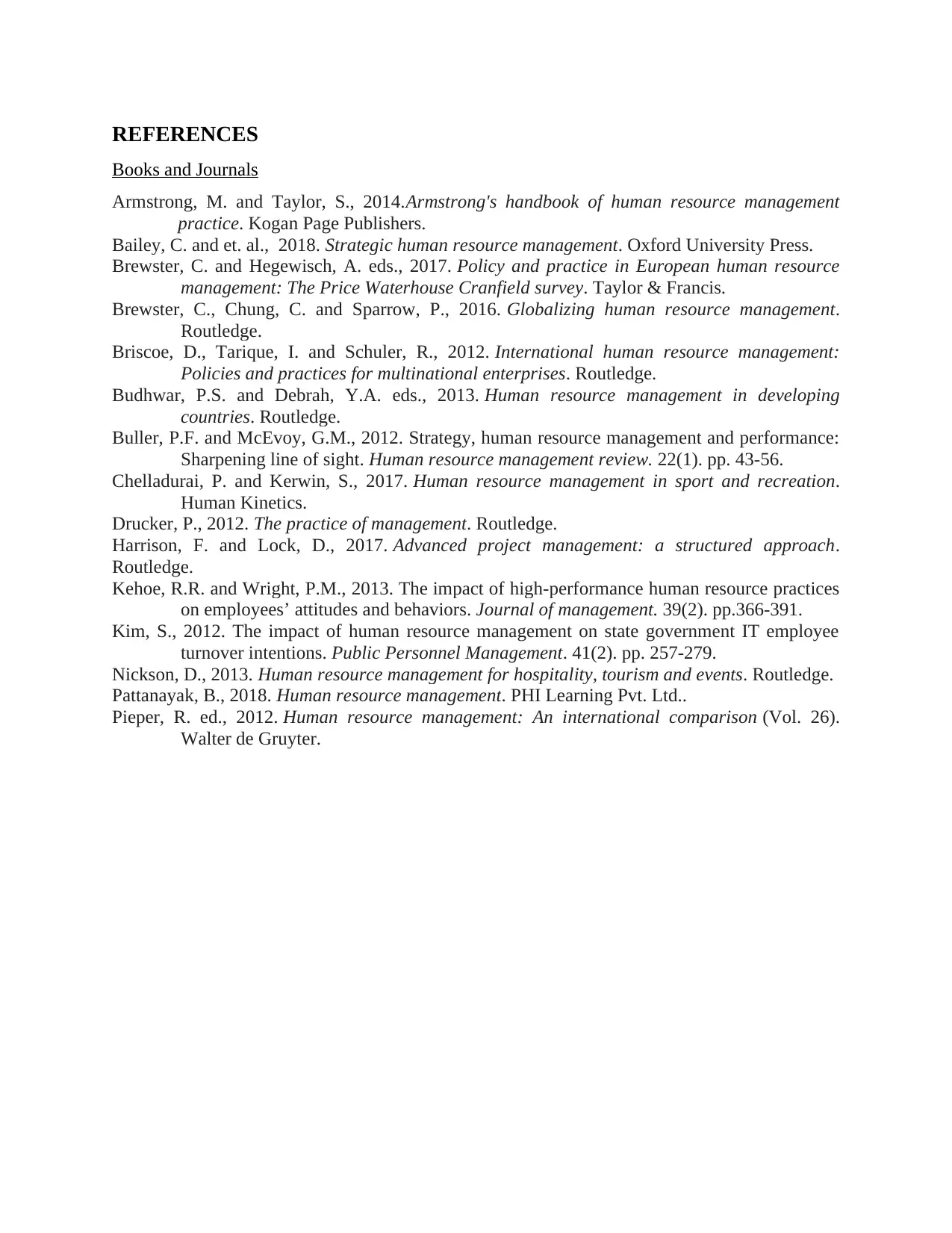
REFERENCES
Books and Journals
Armstrong, M. and Taylor, S., 2014.Armstrong's handbook of human resource management
practice. Kogan Page Publishers.
Bailey, C. and et. al., 2018. Strategic human resource management. Oxford University Press.
Brewster, C. and Hegewisch, A. eds., 2017. Policy and practice in European human resource
management: The Price Waterhouse Cranfield survey. Taylor & Francis.
Brewster, C., Chung, C. and Sparrow, P., 2016. Globalizing human resource management.
Routledge.
Briscoe, D., Tarique, I. and Schuler, R., 2012. International human resource management:
Policies and practices for multinational enterprises. Routledge.
Budhwar, P.S. and Debrah, Y.A. eds., 2013. Human resource management in developing
countries. Routledge.
Buller, P.F. and McEvoy, G.M., 2012. Strategy, human resource management and performance:
Sharpening line of sight. Human resource management review. 22(1). pp. 43-56.
Chelladurai, P. and Kerwin, S., 2017. Human resource management in sport and recreation.
Human Kinetics.
Drucker, P., 2012. The practice of management. Routledge.
Harrison, F. and Lock, D., 2017. Advanced project management: a structured approach.
Routledge.
Kehoe, R.R. and Wright, P.M., 2013. The impact of high-performance human resource practices
on employees’ attitudes and behaviors. Journal of management. 39(2). pp.366-391.
Kim, S., 2012. The impact of human resource management on state government IT employee
turnover intentions. Public Personnel Management. 41(2). pp. 257-279.
Nickson, D., 2013. Human resource management for hospitality, tourism and events. Routledge.
Pattanayak, B., 2018. Human resource management. PHI Learning Pvt. Ltd..
Pieper, R. ed., 2012. Human resource management: An international comparison (Vol. 26).
Walter de Gruyter.
Books and Journals
Armstrong, M. and Taylor, S., 2014.Armstrong's handbook of human resource management
practice. Kogan Page Publishers.
Bailey, C. and et. al., 2018. Strategic human resource management. Oxford University Press.
Brewster, C. and Hegewisch, A. eds., 2017. Policy and practice in European human resource
management: The Price Waterhouse Cranfield survey. Taylor & Francis.
Brewster, C., Chung, C. and Sparrow, P., 2016. Globalizing human resource management.
Routledge.
Briscoe, D., Tarique, I. and Schuler, R., 2012. International human resource management:
Policies and practices for multinational enterprises. Routledge.
Budhwar, P.S. and Debrah, Y.A. eds., 2013. Human resource management in developing
countries. Routledge.
Buller, P.F. and McEvoy, G.M., 2012. Strategy, human resource management and performance:
Sharpening line of sight. Human resource management review. 22(1). pp. 43-56.
Chelladurai, P. and Kerwin, S., 2017. Human resource management in sport and recreation.
Human Kinetics.
Drucker, P., 2012. The practice of management. Routledge.
Harrison, F. and Lock, D., 2017. Advanced project management: a structured approach.
Routledge.
Kehoe, R.R. and Wright, P.M., 2013. The impact of high-performance human resource practices
on employees’ attitudes and behaviors. Journal of management. 39(2). pp.366-391.
Kim, S., 2012. The impact of human resource management on state government IT employee
turnover intentions. Public Personnel Management. 41(2). pp. 257-279.
Nickson, D., 2013. Human resource management for hospitality, tourism and events. Routledge.
Pattanayak, B., 2018. Human resource management. PHI Learning Pvt. Ltd..
Pieper, R. ed., 2012. Human resource management: An international comparison (Vol. 26).
Walter de Gruyter.
1 out of 10
Related Documents
Your All-in-One AI-Powered Toolkit for Academic Success.
+13062052269
info@desklib.com
Available 24*7 on WhatsApp / Email
![[object Object]](/_next/static/media/star-bottom.7253800d.svg)
Unlock your academic potential
Copyright © 2020–2025 A2Z Services. All Rights Reserved. Developed and managed by ZUCOL.




